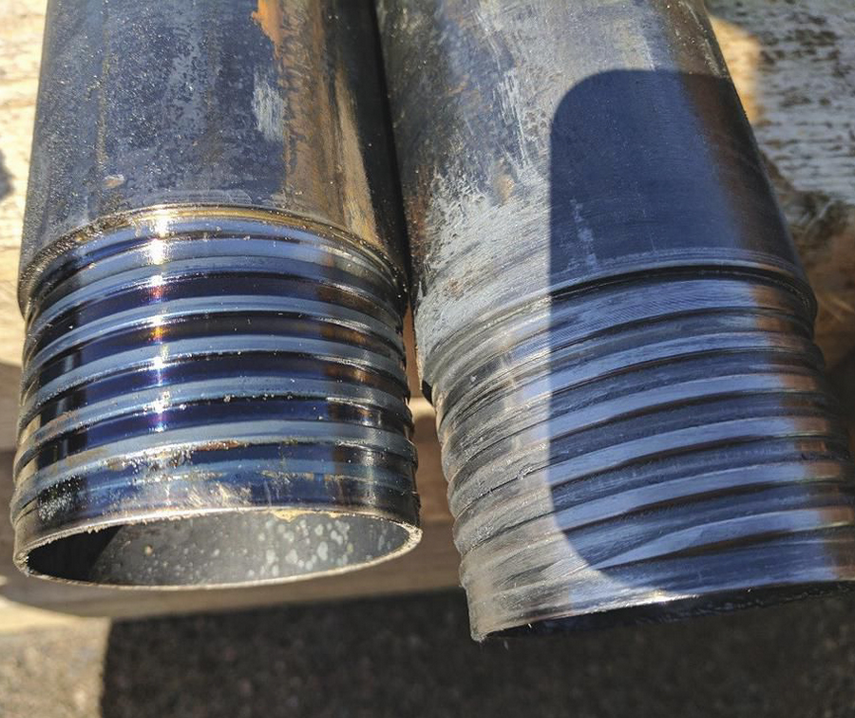Drilling inclined holes, underground, can be one of the more demanding applications for a drill rod string as frictional drag in thrust and torque adds to the weight of the rod string, the fluid column, and the weight on bit. As part of an extensive global test program, employing nearly 10,000 rods at 30 different sites, one of the first strings of NXQ™ rods were deployed to the Boart Longyear Drilling Services expert underground drilling teams operating in the Sudbury mining camp. After drilling through the entirety of 2017 and into 2018, the rods have achieved over 20,700 m of drilling versus a typical life of approximately 12,000 m on NRQ™ rods.
Typical rod life depends on several factors, but the greatest affecting rod life is hole depth. Deep holes tend to increase midbody wear due to the lateral loading and drag caused by helical whirling as well as the greater pullback and torsion required to drill with heavier drill strings. The joints on shallow holes, on the other hand, see a lot more wear and tear as the rod string is tripped in and out of the hole more frequently. On balance, shallow hole rod strings may need to be replaced more often than deep hole strings.
Rod retirement is typically the result of midbody wear, thread wear, or box end wear. Joints that are subjected to high torque loads compress the box end shoulder. High drilling torque can be required in deep down holes but also for short inclined holes underground. High torque can also be locked into the joints as the result of a load spike or dynamic load response. The resulting box shoulder compression causes ‘bulging’ that dramatically increases wear and reduces load capacity as the material wears thin. On traditional single start thread joints, this is observed as a small section of noticeably thin shoulder, nearest where the threads mate.
Box end wear can also result from poor rod handling practices. For example, every time mating rods are accidentally misaligned and ‘stabbed’ during make-up, even lightly, then a small leakage path is formed across the box shoulder face. The leakage from stabbed joints will accumulate and can significantly reduce fluid flow to the bit if excessive. Another source of box wear is caused by excessive deviation or a combination of excessive thrust and rotation speed which creates lateral loading and drag that overheats the box shoulder resulting in ‘heat check cracking’. In heat check cracking, a thin skin of outer material is embrittled and cracks axially, growing across and through the box threads.
Rods can also be retired due to thread wear, which occurs during make and break. Drillers can visually check remaining wear life by monitoring the standoff gap between mating rods, when the pin end is initially stabbed into the box end and the first turns of mating threads contact. Normally multiple turns of thread are visible at this point, but the standoff gap can drop by a full turn of thread given excessive wear. Premature thread wear and retirement can be caused by poor make and break settings. During make and break, the threads are only partially mated which significantly increases contact stresses and wear rates given any load. If there is any tension load, during make or break, then this wear occurs on the thread load flanks which directly reduces drilling load and depth capacity. Always adjust make and break settings towards zero load or slight thrust load, (ie increase feed or reduce rotation speed to avoid tension load on the load flanks).
The operators reported that make-ups were virtually jam-free and that the performance and the fit of the joints remained consistent throughout, due to the self-aligning double-start threads. Underground Coring Canada Division Manager, Mike Garton, said about this string and others, “The new XQ thread provides the smoothest making and breaking of any rod I have used in my 25-year career in drilling. The XQ rods align better and don’t require back-turning the rods to start – saving time. Jamming rods during making and breaking lowers productivity, so not having the rods jamming means more meters. The XQ rods coming out of the hole are not showing the typical box or thread wear, which means the rods last longer too. The strength and depth capability are by far the best in the market. When drilling deep holes that need to hit specific targets or underground drilling, this rod outperforms them all. I highly recommend the XQ wireline coring rods.”











